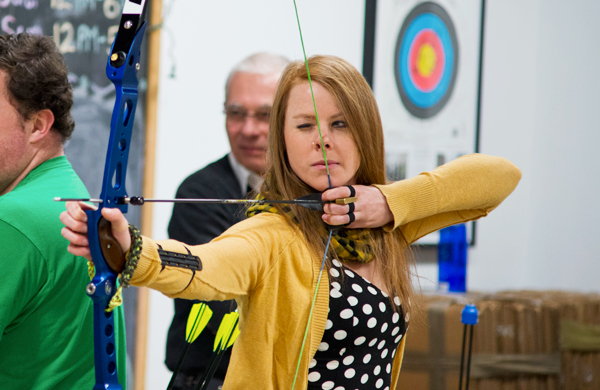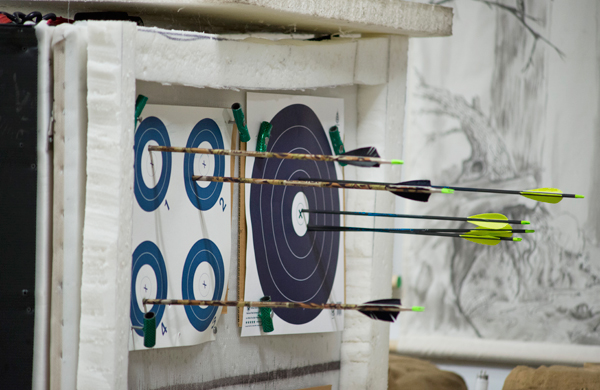
Located in a warehouse just north of Humboldt Park, Archery Bow Range Chicago doesn’t look like much from the street. But inside the cavernous space, you’ll find a 20-yard indoor archery range and a 20-foot training range. You’ll also find plenty of students shakily holding their bows, worried less about hitting a bull’s-eye than hitting someone else’s eye.
That’s where Jonas Lumayag steps in. The way Jonas sees it, archery isn’t just the province of Olympians and elves. Almost every Saturday, he teaches newcomers to shoot with confidence in archery for beginners clinics. One of two clinic instructors, Jonas actually started in an intro clinic himself. The bow soon came to feel like a natural extension of his body.
Jonas says his beginner’s archery lessons are a great way to learn to shoot an arrow for the first time. “They take you step by step,” he said. “Like any sport, if you don't have proper direction, it takes longer to learn.”
OK, I’ll admit it: a part of me wants to be Katniss Everdeen, or at least Merida from Brave. So I signed up for ABRC’s Intro to Archery clinic to learn how to shoot arrows straight. Or at least not backward.

Step 1: Follow the Rules or Pay with Delicious Baked Goods
To keep their intro clinic from turning into a medieval battlefield, the bow range has only four rules:
- Don’t shoot yourself.
- Don’t shoot each other.
- Don’t dry shoot (“dry shooting,” I learned, means releasing the line without an arrow in it).
- Have fun.
Seems easy enough, right? Beginner and intermediate shooters use the shorter of the two indoor archery ranges to get their control down before trying for distance. The 20-foot target is close enough that you don’t need to focus too much on power.
Over in the advanced range, it’s a different story. The targets are 20 yards away from the shooting line, and the archers seem to routinely hit bull’s-eyes barely visible to the naked eye. When one of these pros misses with a wild shot, they pay for it with pushups or a tray of cookies for their peers. So if you’re at the range and hear someone yell "Duck!", expect it to be followed with a chorus of "Cookies!"

Step 2: Figure Out Which of Your Eyes Is Dominant
As I lined up with my group, I noticed how diverse the other shooters were. There were little kids, retirees, and even some younger couples on dates. When the class split into three smaller groups to shoot our first arrows, I encountered an unexpected problem—I had no idea which hand to use.
Jonas helpfully explained that my bow hand isn’t necessarily the one I write with. He showed our group how to use the “eye test” to judge which eye is dominant. Once everyone figured that out, he instructed us to shoot with our dominant eye closest to the arrow.
So, you might be asking, what’s this eye test all about? It’s simple: face any target—be it an exit sign or a donut nailed to your bedroom wall—and extend your hands away from your body, creating a small, triangular window with your thumbs touching and your index fingers overlapping. Then, pull your hands toward you without taking your eyes off the target. The dominant eye is whichever eye your hands land on. I happened to be one of only two lefties in my group, even though I’m normally right-handed.

Step 3: Archers, Take Your Position
“Now comes the fun part,” I thought as Jonas handed out bows. I got a yellow one named Sunny—not exactly a name that would strike fear into an oncoming orc, but no matter. Grasping my new weapon, I lined up to face the target. Left-eye dominant shooters stand with their right shoulders forward, while right-eye dominant shooters do the opposite.
A proper archery stance requires the feet to be shoulder-width apart. We stood with our legs on either side of a red line, our bodies straight and our arms extended (“In true Katniss fashion,” I thought). With the three middle fingers of my left hand, I pulled back the arrow until my hand rested against my cheek. Sensing some tension, Jonas reminded me to relax. "At first, it’s just about getting used to holding the bow," he said.
I’d be lying if I said I wasn’t nervous, which isn’t exactly a bad thing to be around weapons. Luckily, Jonas is used to beginners coming in with a few nerves. “When you're doing something new, it’s intimidating enough to show up,” he said. “This is one of those sports where you’re your own worst enemy. You just need to have a bit of confidence.” Easy enough to say, less easy to do.
Step 4: Ready, Aim, Fire
Apparently, there’s a basic method for hitting the center of a target. All you have to do is look down the arrow shaft, aim at the center, and release the string. As you might imagine, it’s harder than it sounds. Jonas said the best piece of advice he ever got was “Hey man, just shoot the middle and you'll be OK."
My first arrow clattered off the target and hit the ground. Sensing weakness, Jonas came over to help, showing me how to point my elbow out so that the arrow wouldn’t sting.
The next round? I hit myself again.

Step 5: Now Try to Actually Hit the Target
Each shot I took after those initial duds was dramatically better than the last. Jonas advised students to aim low—”the arrow will fly higher than you think.” Making small adjustments, I discovered, can really move the arrow to where it needs to go.
By the third round, I was hitting close to the center of the target.
Katniss I may never be, but the day was far from unsuccessful. Besides, Jonas said, beginners often realize that archery lessons are much harder than they looks. “You can see the attitude change from, ‘We’re just shooting and having fun!’ to ‘Aw, man, this is so hard!’”
Still, helping newcomers improve is one of Jonas’s favorite parts of teaching archery for beginners. “That's what we’re here for,” he said. “We always want them to have a good experience with it because the positive experience will encourage people to take it further.” Maybe not as far as The Hunger Games, but close enough.







